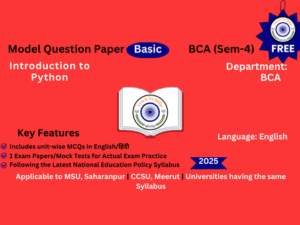कार्बनिक संश्लेषण A (सेमेस्टर -5)
- Description
- Curriculum
- Reviews

Teach To India प्रकाशन
कार्बनिक संश्लेषण A
-
यह मॉडल पेपर यह सुनिश्चित करता है कि सभी संभावित प्रश्न जो परीक्षा में आ सकते हैं, वे यूनिट में पूरी तरह से शामिल हैं, चाहे वे सीधे हों या अप्रत्यक्ष रूप से।
-
इसे अनुभवी प्रोफेसरों द्वारा बहुत सावधानी से तैयार किया गया है, जिन्हें परीक्षा मॉडल पेपर बनाने का व्यापक अनुभव है।
-
इस पेपर में विश्वविद्यालय द्वारा निर्धारित पाठ्यक्रम के आधार पर सभी मुख्य प्रश्न शामिल हैं।
-
400 से अधिक प्रश्न और उत्तरों के साथ, यह मॉडल पेपर विषय का पूरा पाठ्यक्रम कवर करता है।
-
प्रत्येक यूनिट में दीर्घ उत्तरीय ,लघु उत्तरीय और अति लघु उत्तरीय वाले प्रश्न शामिल हैं ताकि छात्रों को गहन समझ प्राप्त हो सके।
-
हमारे प्रश्न इस तरह तैयार किए गए हैं कि प्रत्येक यूनिट को कम से कम और अच्छी तरह चुने हुए प्रश्नों से कवर किया जा सके।
-
अनिवार्य आंतरिक परीक्षा के लिए हम 200 एक पंक्ति के प्रश्न-उत्तर प्रदान कर रहे हैं, जो प्रत्येक यूनिट को समान रूप से कवर करते हैं।
-
इस मॉडल पेपर में मॉक प्रश्नपत्र / पिछले साल के प्रश्नपत्र भी हल के साथ दिए गए हैं, जिससे छात्रों को परीक्षा के प्रश्नों की गहराई और विस्तार को समझने में मदद मिलती है।
|
Programme /Class: Degree in Bachelor of Science |
Year: Third |
Semester: Vth
|
||
|
Compulsory Subject: Chemistry |
||||
|
Course Title: Organic Synthesis A |
||||
|
Course outcomes: Hydrocarbons are the principal constituents of petroleum and natural gas. They serve as fuels and lubricants as well as raw materials for the production of plastics, fibers, rubbers, solvents and industrial chemicals. This course will provide a broad foundation in for the synthesis of hydrocarbons. Hydroxy and carbonyl compounds are industrially important compounds The industries of plastics, fibers, petroleum and rubbers will specially recognize this course. Students will gain an understanding of which are used as solvents and raw material for synthesis of drug and other pharmaceutically important compounds. Synthesis and chemical properties of aliphatic and aromatic hydrocarbon .Synthesis and chemical properties of alcohols, halides carbonyl compounds, carboxylic acids an esters. How to design and synthesize aliphatic and aromatic hydro carbons. How to convert aliphatic and aromatic hydrocarbons to other industrially important compounds. Functional group inters conversion.
|
||||
|
Credits: 4 |
Elective |
|||
|
Max. Marks: 25+75 |
Min. Passing Marks: 8+25 |
|||
|
Unit |
Topics |
|||
|
I |
Chemistry of Alkanes and Cycloalkanes Alkanes :Classification of carbon atom in alkanes, General methods of preparation, physical and chemical properties of alkanes: Wurtz Reaction, Wurtz-Fittig Reactions, Free radical substitutions: Halogenation -relative reactivity and selectivity Cycloalkanes: Nomenclature, methods of formation, chemical reactions, Baeyer’s strain theory and its limitations. Chair, Boat and Twist boat forms of cyclohexane with energy diagrams ring strain in small rings, theory of strain less rings. The case of cyclopropane ring, banana bonds.
|
|||
|
II |
Chemistry of Alkenes Methods of formation of alkenes, Addition to C=C: mechanism (with evidence wherever applicable), reactivity, regioselectivity (Markownikoff and anti-Markownikoff additions) and stereoselectivity; reactions: hydrogenation, halogenation, hydrohalogenation, hydration, oxymercuration demercuration, hydroboration-oxidation, epoxidation, syn and anti-hydroxylation, ozonolysis, addition of singlet and triplet carbenes; Simmons-Smith cyclopropanation reaction; electrophilic 12 36 addition to diene (conjugated dienes and allene); radical addition: HBr addition; mechanism of allylic and benzylic bromination in competition with brominations across C=C; use of NBS; interconversion of E- and Z- alkenes.
|
|||
|
III |
Chemistry of Alkynes Methods of formation of alkynes, Addition to C≡C, mechanism, reactivity, regioselectivity and stereoselectivity; reactions: hydrogenation, halogenations, hydrohalogenation, hydration, oxymercuration demercuration, hydroboration-oxidation, dissolving metal reduction of alkynes (Birch); reactions of terminal alkynes by exploring its acidity; inter conversion of terminal and non terminal alkynes. Chemistry of Alkynes Methods of formation of alkynes, Addition to C≡C, mechanism, reactivity, regioselectivity and stereoselectivity; reactions: hydrogenation, halogenations, hydrohalogenation, hydration, oxymercuration demercuration, hydroboration-oxidation, dissolving metal reduction of alkynes (Birch); reactions of terminal alkynes by exploring its acidity; inter conversion of terminal and non terminal alkynes.
|
|||
|
IV |
Aromaticity and Chemistry of Arenes Nomenclature of benzene derivatives, MO picture of benzene, Aromaticity: Hückel’s rule, aromatic character of arenes, cyclic carbocations/carbanions. Electrophilic aromatic substitution: halogenation, nitration, sulphonation and Friedel-Craft’s alkylation/acylation with their Mechanism. Directing effects of the groups. Birch reduction, Methods of formation and chemical reactions of alkylbenzenes, alkynylbenzenes and biphenyl, naphthalene and anthracene.
|
|||
|
V |
Chemistry of Alcohols Classification and nomenclature, Monohydric alcohols – nomenclature, methods of formation by reduction of Aldehydes, Ketones, Carboxylic acids and Esters, Hydrogen bonding, Acidic nature, Reactions of alcohols. Dihydric alcohols nomenclature, methods of formation, chemical reactions of vicinal glycols, oxidative cleavage [Pb(OAc)4 and HIO4] and pinacol pinacolone rearrangement. Trihydric alcohols – nomenclature, methods of formation, chemical reactions of glycerol.
|
|||
|
VI |
Chemistry of Phenols : Nomenclature, structure and bonding, preparation of phenols, physical properties and acidic character, Comparative acidic strengths of alcohols and phenols, resonance stabilization of phenoxide ion. Reactions of phenols – electrophilic aromatic substitution, acylation and carboxylation. Mechanisms of Fries rearrangement, Claisen rearrangement, Gatterman syntheis, Hauben Hoesch reaction, Lederer-Manasse reaction and Reimer-Tiemann reaction
|
|||
|
VII |
Chemistry of Ethers and Epoxides: Nomenclature of ethers and methods of their formation, physical properties, Chemical reactions – cleavage and autoxidation, Ziesel’s method. Synthesis of epoxides, Acid and base-catalyzed ring opening of epoxides, orientation of epoxide ring opening, reactions of Grignard and organolithium reagents with epoxides.
|
|||
|
VIII |
Chemistry of Organic Halides Nomenclature and classes of alkyl halides, methods of formation, chemical reactions, Mechanisms of nucleophilic substitution reactions of alkyl halides, SN2 and SN1 reactions with energy profile 05 37 diagrams; Polyhalogen compounds : Chloroform, carbon tetrachloride; Methods of formation of aryl halides, nuclear and side chain reactions; The addition-elimination and the eliminationaddition mechanisms of nucleophilic aromatic substitution reactions; Relative reactivities of alkyl halides vs allyl, vinyl and aryl halides, Synthesis and uses of DDT and BHC
|
|||







